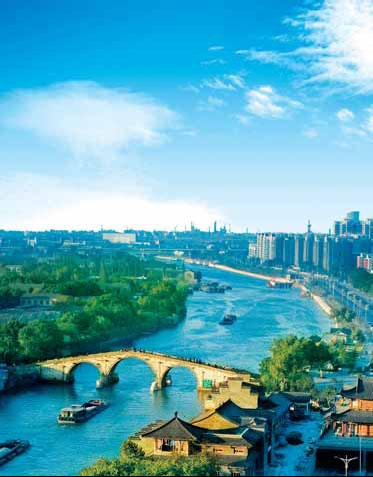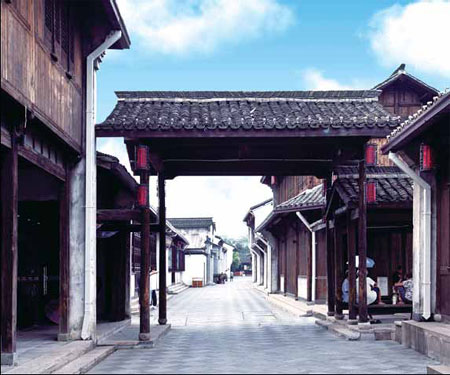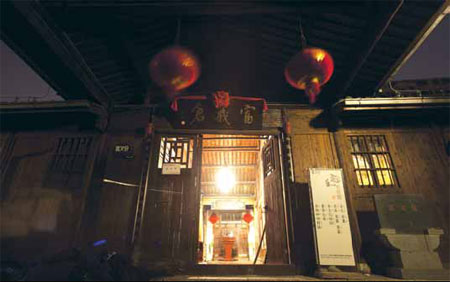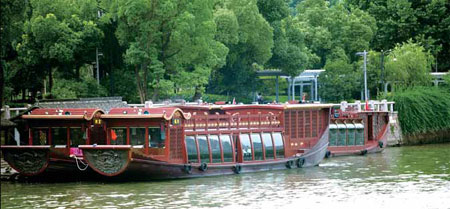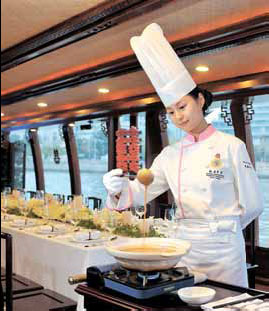History flows through Grand Canal
Updated: 2012-05-31 08:09
By Zhuan Ti (China Daily)
|
||||||||
|
Gongchen Bridge is the highest and longest of Hangzhou's many historic bridges. |
|
A group of retirees relaxes and chats on a historical street in the Qiaoxi district. |
|
Fuyi Cang, a granary along the canal founded in 1884, is an important part of Hangzhou's cultural heritage. |
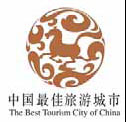
China's Grand Canal is the longest and oldest manually built canal in the world.
Starting at Beijing in the north, it passes through Tianjin and goes through the provinces of Hebei, Shandong, Jiangsu and Zhejiang before reaching the city of Hangzhou in the south.
It is 1,794 kilometers long and connects five major rivers in China: the Haihe River, the Yellow River, the Huai River, the Yangtze River and the Qiantang River.
Construction on this canal began in the fifth century BC, and later the various sections were finally combined during the Sui Dynastry (AD 581-618), linking the productive southern fishing and farming region to the northern capitals. As an important water route for business, it allows faster trading and furthered the growing economic market in urban centers through all the ages since the Sui period.
Hangzhou is one of the thriving trading centers along the canal. The section of the Grand Canal in Hangzhou runs 39 km across four districts in the city, and it has a basin area of 726.6 square kilometers.
Thanks to its long history of prosperity, the city possesses numerous ancient buildings, including not only ancient docks and business streets but also temples, academies for classical learning and stone tablets.
Since the protective development of the rich natural and cultural resources along this section began in 2002, the Hangzhou government has conducted many programs to improve the water quality and repair ancient buildings to form an area themed on water tourism.
Sitting in a boat floating down the Hangzhou section of the Grand Canal tourists can appreciate the beautiful natural scenes, bridges and other buildings along the bank. They also can visit many heritage sites and historical towns.
Cultural relics
Fuyi Cang, a granary along the canal founded in 1884, witnessed the heyday of the rice trade and canal transportation. It's an important part of Hangzhou's cultural heritage, showing the rich history of this section of the Grand Canal.
It covers about 8,000 square meters, with a gross building area of 3,000 square meters. As a famous cultural scenic spot, it also functions as a platform for creativity and art.
Xiangji Temple, founded in 978, got its name from Emperor Zhenzong of the Song dynasty. It is the first temple seen by visitors to Hangzhou arriving via the canal, thus many people went to the temple first when they went on shore after a long travel and rested for a night there before they moved on.
The temple has received thousands of visitors since renovations were completed in 2010.
The refurbished temple, covering 16,855 square meters, has embraced a new design in terms of style, composition and construction material by using lots of wood and copper. The temple's solemn halls are complemented with casual dining in its adjoining vegetarian restaurant.
Industry heritages
Three museums have been built in some existing warehouses along the canal to present precious collections and splendid histories of swords, umbrellas and paper fans, which were all traditional products in ancient China.
The preliminary construction of these three museums finished in 2009, and they are now open for the public. The museums will play an important supporting role in the Grand Canal's application of World Heritage.
In the Museum of Knives and Swords, tourists can see swords from ancient times and relive the long history of the sword's development in China.
In the China Umbrella Museum, all kinds of umbrellas can be seen, including some from Hangzhou as well as other areas of China and the world. Visitors can also learn how to make an umbrella and how to dance with them.
In the China Fan Museum, tourists can get a clear picture of the development of fans in China through vivid presentations using multimedia. Moreover, Hangzhou has been the cultural center of the fan industry since Song Dynasty (960-1297).
Historical districts
The city of Hangzhou has three major historical districts that border the canal.
The first is the historical district of Xiaohezhijie, which is located in a place where three rivers meet. Xiaohezhijie Street forms the center of the district.
Many families living on this street have maintained their lifestyles and occupations, while other families have converted their traditional houses into miniature galleries for calligraphy and photographs. This street was listed as recommended tourist site along the Grand Canal in 2012.
This historical district also has many time-honored shops, such as Dinglianfang stuffed bun houses, which carry on local traditions.
The second major historical district is Qiaoxi, located on the western side of Gongchen Bridge.
It is known for its numerous buildings from various different time periods.
In this district, people can see ancient buildings that have stood for thousands of years beside houses built in the first years of last century and the simple apartments of 1950s as well as the tube-shaped apartments of the 1980s. In addition to residential housing, lots of warehouses, workshops and temples can also be found here.
Qiaoxi district has set a goal of building at street with a focus on traditional Chinese medicine and healthcare. Many famous traditional enterprises, such as Fanghuichun Tang, founded in 1649, have opened branches here.
The last historical district and the one with the longest history is Dadoulu historical district, which has a length of 780 meters from south to north and a width of 150 meters from east to west.
The Fuyi Cang and Xiangji Temple, mentioned in the previous part, are also located here.
The streets in these districts formed the distribution center of rice, fish, paper and fruit after the Grand Canal became an important transportation channel. Hundreds of boats came and left from ports in this districts.
After the preservation program started in 2009, this district has begun to regain its former luster thanks to a renovation of traditional buildings and booming business in catering and trade.
zhuanti@chinadaily.com.cn
|
Large boats like these were used for transporting grain to the capital in feudal times. |
|
Modern tourism boats have traded their grain for fine cuisine. |
(China Daily 05/31/2012 page10)

 'Taken 2' grabs movie box office crown
'Taken 2' grabs movie box office crown
 Rihanna's 'Diamonds' tops UK pop chart
Rihanna's 'Diamonds' tops UK pop chart
 Fans get look at vintage Rolling Stones
Fans get look at vintage Rolling Stones
 Celebrities attend Power of Women event
Celebrities attend Power of Women event
 Ang Lee breaks 'every rule' to make unlikely new Life of Pi film
Ang Lee breaks 'every rule' to make unlikely new Life of Pi film
 Rihanna almost thrown out of nightclub
Rihanna almost thrown out of nightclub
 'Dark Knight' wins weekend box office
'Dark Knight' wins weekend box office
 'Total Recall' stars gather in Beverly Hills
'Total Recall' stars gather in Beverly Hills
Most Viewed
Editor's Picks

|

|

|

|

|

|
Today's Top News
Health new priority for quake zone
Xi meets US top military officer
Japan's boats driven out of Diaoyu
China mulls online shopping legislation
Bird flu death toll rises to 22
Putin appoints new ambassador to China
Japanese ships blocked from Diaoyu Islands
Inspired by Guan, more Chinese pick up golf
US Weekly

|

|
